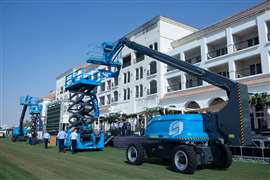What's driving demand for super heavy lifters?
14 January 2013

While some of the mainstream crane manufacturers are active at the top end of the heavy lift arena, the “bigger” news is from the end users who have independently designed and built super heavy lift cranes. Nuclear power station construction in the USA, China and elsewhere has driven demand, as has activity in the petrochemical, ship building and offshore energy equipment construction industry worldwide.
Design approaches vary, from types most similar to conventional cranes – Mammoet, Lampson, Sarens – to variations that are less so with, for example, strand jacks or no counterweight – ALE, Bigge.
Bigge Crane & Rigging in the USA has its 125D AFRD, which it describes as the world’s largest capacity crane at radius. Bigge gives the capacity of the ARFD as 7,500 US tons (6,800 tonnes) on 300 feet (91 m) of main boom and 4,000 tons (3,630 tonnes) with 560 feet (171 m) of main boom. Fixed jibs will be available in excess of 1,000 tons (907 tonnes) capacity and 200 feet (61 m) long, according to Pete Ashton, vice president of major projects.
“The market continues to demand higher capacity machines to accommodate accelerated construction methods,” says Ashton. Features distinguishing the AFRD are “high speed performance machinery for slewing, hoisting and booming, exceptional and unmatched capacity at radius, automatic self levelling, state-of-the-art safety features, modular components for ease of assembly and economical transportation,” Ashton explains.
Also based in the USA is Lampson International, which has been in heavy lift cranes since the 1970s. The company’s Transi-Lift cranes are familiar at nuclear power plants around the world, says Kate Lampson.
The largest Lampson, the LTL-3000, has a capacity of 3,000 tons. The Transi-Lift system is a patented configuration that combines the heavy lifting capacities of stiff leg derricks and ring mounted lift equipment with the mobility of a conventional crawler crane.
“All Transi-Lift models boast precise manoeuvrability, adjustable stinger length, and multiple boom and jib combinations, allowing us to work in smaller foot prints and challenging spaces,” Lampson explains.
“We are seeing a steady demand for our heavy lift cranes both in the United States and abroad,” says Lampson. “Most of these projects focus on large plant construction, including nuclear, gas, and electric power plants, deconstruction of manufacturing plants, refinery work, and some wind farm construction.”
Super giant crane
With its origins in the USA at subsidiary Rigging International, Belgium-based international specialist Sarens’ contender is the SGC-120 with 3,200 tonnes capacity at 30 metres radius and 1,000 tonnes at 80 m. Announced in 2010, the ring-based unit lifts like a conventional crane, with winches, as do the Bigge, Lampson and Mammoet offerings. Like the ALE and Mammoet models, it was designed for flexible worldwide transportation in standard shipping containers.
“This crane is best suited for lifting modules, PAS, PAU and FPSOs,” says Marcel Roovers, Sarens global sales director. “It will work in chemical and power plants and nuclear plants.” Roovers says that as these components get bigger they still want to reduce the cost of transport and erection time. “The increased crane capacity and the larger components are increasing gradually and, even if we do not have the required crane capacity we can use alternative lifting methods such as towers,” he says. “As the cranes become larger, they can take over from the towers – moving them to lift the even larger capacity components and so on.”
Roovers says the lead time to build these cranes is between three and four years, “so you are always taking a risk because this is longer than the contract lead time. Planned projects do not always come to realisation – the Japanese nuclear disaster put a stop to many contracts which contractors were gearing up for.”
In addition, Roovers continues, “clients bring in external consultants to check the procedures and calculations, etc., so it takes a long time before you get the green light. Overall this is not such a bad thing because having an independent check further improves safety.”
After its inaugural job in Phoenix, Arizona, the SGC-120 went to China where it is working to build an oil platform on the Cheviot Octabuoy project at the Cosco Shipyard in Nantong, near Shanghai. Several modules are being lifted for the topside drilling platform, with a total weight of 15,000 tonnes. Modules weighing up to 1,300 tonnes will be lifted (see the dedicated site report in this issue).
Massive Mammoet
Needing little introduction as the world’s biggest player in the heavy lift and transport sector is Mammoet, based in the Netherlands. Following its announcement in August 2009, Mammoet’s first 3,200 tonne capacity, 200,000 tonne-metre, PTC 200 DS left Europe after testing for its first project, in Brazil, at the end of 2011. For more details on the super PTC see International Cranes and Specialized Transport magazine July 2011 issue page 15.
The other two Super PTCs have since been put to work in the USA. One in Ingleside, Texas, where it is set up in an offshore yard for the assembly of an offshore oil rig and the other in Louisiana (see the dedicated site report in this issue).
The Super PTCs are fully containerised, have a maximum ground bearing pressure of 20 tonnes per square metre and a slew speed of 360 degrees in 15 minutes. A 3,200 tonne load can be hoisted to a height of 120 m in 12 minutes.
British entry
In July 2012, UK-headquartered ALE announced that it will build the 5,000 tonne capacity AL.SK350 super heavy lifter. ALE said it will be the world’s highest capacity land-based crane with a load moment 77% higher than its nearest rival. It will be built by adding extra structural sections to the company's existing 4,300 tonne capacity AL.SK190.
The main hoist is by strand jacks and it will also have a 2,000 tonne capacity winch for lighter loads. Its main boom will be 141.2 m and a 120 m jib will be available. In mid-2013 it will start on a long-term contract at the OSX Shipbuilding Unit in Açu, Brazil. It will install modules onto the hulls of FPSOs.
ALE has two of the smaller AL.SK190 models, launched in 2008, that have been working around the world. On the Thai growth project in Thailand the AL.SK190 completed all lifts in a third of the time required by any other crane, ALE said. At the Valero Port Arthur, Texas, project a 190 made the first lift of a complete six coke drum derrick assembly weighing 1,600 tonnes.






